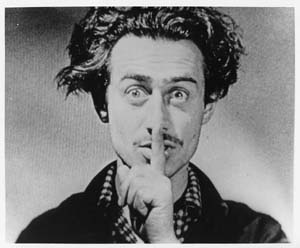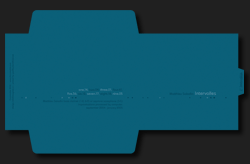 Just a note: First new recording of 2007 that I've really, really liked: Matthieu Saladin's "Intervalles" on l'Innomable
Just a note: First new recording of 2007 that I've really, really liked: Matthieu Saladin's "Intervalles" on l'InnomableNine pieces for computer enhanced bass clarinet and soprano saxophone, beautifully restrained, always fascinating.
 Just a note: First new recording of 2007 that I've really, really liked: Matthieu Saladin's "Intervalles" on l'Innomable
Just a note: First new recording of 2007 that I've really, really liked: Matthieu Saladin's "Intervalles" on l'Innomable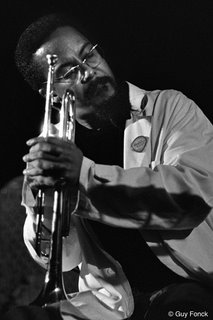 When someone stops me on the street and says, "Olewnick, if you had to pick one piece that epitomizes the best in post-Coltrane avant jazz, what would it be?" (this occurs three or four times daily) I usually answer, "Ohnedaruth, from the Art Ensemble's 'Phase One' on Prestige", from 1971.
When someone stops me on the street and says, "Olewnick, if you had to pick one piece that epitomizes the best in post-Coltrane avant jazz, what would it be?" (this occurs three or four times daily) I usually answer, "Ohnedaruth, from the Art Ensemble's 'Phase One' on Prestige", from 1971. "Bap-Tizum". Well, what can one say? As I said before, this was my intro to the band and the damn thing still kills. A live set from the Ann Arbor Blues and Jazz Festival, September 9, 1972, introduced by John Sinclair to a crowd of 10,000, as he says in the liners, "most of whom had never heard anything like this music before in their young lives." It was the sort of set that would typify and AEC performance in years to come: An opening, Moye-led percussion piece that's super powerful. To this day, when I'm idly tapping out rhythms somewhere, I'm likely to fall into this piece (either this or Reich's 'Drumming'). Moans and screams lead into Favors' "Immm" (boy do I miss the titles from those days!), a spacey, part spoken word piece that actually works. Then there's Roscoe and his structure, his perverse sense of pacing and slab-like constructiveness, "Unanka". A sublime theme leads to a funereal bass rhythm over which Mitchell plays so deliciously off, so against his accompaniment. This is a piece I had a good deal of trouble with as a young 'un but have come to really appreciate. Side two begins with Mitchell's short and hectic "Oouffnoon" (!!!) featuring splattering Bowie before segueing into another version of "Ohnedaruth", perhaps not quite as earthshaking as the one on "Phase One", but still pretty great. Bowie (I think it's Bowie) gets so worked up during his solo that he begins shouting something like, "...Fan...dang....Fuck those motherfuckers, man! They aren't gonna go tell you shit, man!!" Ah and then "Odwalla", I believe for the first time on record. What a timeless, beautiful theme, so forcefully stated by the paired bass saxophones, the line iterated with variations for several minutes before they strut
"Bap-Tizum". Well, what can one say? As I said before, this was my intro to the band and the damn thing still kills. A live set from the Ann Arbor Blues and Jazz Festival, September 9, 1972, introduced by John Sinclair to a crowd of 10,000, as he says in the liners, "most of whom had never heard anything like this music before in their young lives." It was the sort of set that would typify and AEC performance in years to come: An opening, Moye-led percussion piece that's super powerful. To this day, when I'm idly tapping out rhythms somewhere, I'm likely to fall into this piece (either this or Reich's 'Drumming'). Moans and screams lead into Favors' "Immm" (boy do I miss the titles from those days!), a spacey, part spoken word piece that actually works. Then there's Roscoe and his structure, his perverse sense of pacing and slab-like constructiveness, "Unanka". A sublime theme leads to a funereal bass rhythm over which Mitchell plays so deliciously off, so against his accompaniment. This is a piece I had a good deal of trouble with as a young 'un but have come to really appreciate. Side two begins with Mitchell's short and hectic "Oouffnoon" (!!!) featuring splattering Bowie before segueing into another version of "Ohnedaruth", perhaps not quite as earthshaking as the one on "Phase One", but still pretty great. Bowie (I think it's Bowie) gets so worked up during his solo that he begins shouting something like, "...Fan...dang....Fuck those motherfuckers, man! They aren't gonna go tell you shit, man!!" Ah and then "Odwalla", I believe for the first time on record. What a timeless, beautiful theme, so forcefully stated by the paired bass saxophones, the line iterated with variations for several minutes before they strut l playing. Sinclair returns to the mic, "A mighty band indeed!" Indeed.
l playing. Sinclair returns to the mic, "A mighty band indeed!" Indeed. I've long been of the opinion that there are six Art Ensemble releases that stand above the rest and that, conveniently enough, they fall into three pairs:
I've long been of the opinion that there are six Art Ensemble releases that stand above the rest and that, conveniently enough, they fall into three pairs: dering it from New Music Distribution Service pretty quickly after having heard "Bap-Tizum". Great cover, too, Roscoe looking especially cool. Incidentally, I just noticed checking at AMG that "Certain Blacks" is listed with a recording date of 2/12/70; my copy on Inner City was without a date. I assumed it was from around the same time, but hadn't realized it pre-dated Sophie by five months. It goes to a point I was going to make later that, as great as their stuff was from this period, they were by no means absolutely consistent, "Certain Blacks" being something of a blowing session, not bad, but not as profound as other work they were doing contemproaneously. Anyway, back to Sophie: Has there ever been a greater example of avant jazz/rock/funk hybrid than "Theme de Yoyo"? Not in this listener's book. I love Miles as much as the next guy, but this song has killed me from Day One and continues to do so decades on. Everything perfect, even from a pop song standpoint, given its length--nothing goes on too long, each statement is precise and impassioned, Fontella Bass' voice just oozes sex. What more could you want? And the rest of the album is just about as good. Again, they managed to achieve an amazing level of maturity in a short time. There's not a wasted sound here. And Don Moye....it's like a championship baseball team calling up a superstar from AAA. Cemented everything.
dering it from New Music Distribution Service pretty quickly after having heard "Bap-Tizum". Great cover, too, Roscoe looking especially cool. Incidentally, I just noticed checking at AMG that "Certain Blacks" is listed with a recording date of 2/12/70; my copy on Inner City was without a date. I assumed it was from around the same time, but hadn't realized it pre-dated Sophie by five months. It goes to a point I was going to make later that, as great as their stuff was from this period, they were by no means absolutely consistent, "Certain Blacks" being something of a blowing session, not bad, but not as profound as other work they were doing contemproaneously. Anyway, back to Sophie: Has there ever been a greater example of avant jazz/rock/funk hybrid than "Theme de Yoyo"? Not in this listener's book. I love Miles as much as the next guy, but this song has killed me from Day One and continues to do so decades on. Everything perfect, even from a pop song standpoint, given its length--nothing goes on too long, each statement is precise and impassioned, Fontella Bass' voice just oozes sex. What more could you want? And the rest of the album is just about as good. Again, they managed to achieve an amazing level of maturity in a short time. There's not a wasted sound here. And Don Moye....it's like a championship baseball team calling up a superstar from AAA. Cemented everything. me correct me if I'm mistaken). [Whoops, I think I'm wrong, happily; just found it] Wonderful photo of Bass on the back; looks like frlom around the same time as this one. Each album features two side-long tracks. "How Strange/Ole Jed" opens with a fantastic African (Afro-Cuban) percussion/chant that I'm guessing Moye brought in. If anyone knows the source, please let me know. Interestingly, the section concludes with exactly the same conga pattern as the piece at the beginning of "Bap-Tizum". The main theme, a folk tale about Ole Jed falling into a well, sounds to me like the work of Favors with its southern inflections. It harkens a bit back to "The Spiritual", Bass laughing through some of the lyrics, before turning more somber near its end, all low horns and flute before a very short but riotous finale. Lovely piece. Mitchell's "Horn Web" (what a great title!) is more overtly experimental, beginning with an intense Moye solo before encountering a handful of pointillist blasts, then a soft arco bass/muted horns passage. Will's fascination with Mitchell's structural use of sound is in clear evidence here, the piece unfolding in slabs. There's what appears to be some group improvisation (I wonder if any rules were in effect) but even here, his flute acts like a sheepdog. It's spacey, something the AEC was often (sometimes justafiably) criticised for being, but here it all gels--diaphanous without evaporating entirely. There's a hint of the "Odwalla" theme buried inside as well some luscious horn harmonies.
me correct me if I'm mistaken). [Whoops, I think I'm wrong, happily; just found it] Wonderful photo of Bass on the back; looks like frlom around the same time as this one. Each album features two side-long tracks. "How Strange/Ole Jed" opens with a fantastic African (Afro-Cuban) percussion/chant that I'm guessing Moye brought in. If anyone knows the source, please let me know. Interestingly, the section concludes with exactly the same conga pattern as the piece at the beginning of "Bap-Tizum". The main theme, a folk tale about Ole Jed falling into a well, sounds to me like the work of Favors with its southern inflections. It harkens a bit back to "The Spiritual", Bass laughing through some of the lyrics, before turning more somber near its end, all low horns and flute before a very short but riotous finale. Lovely piece. Mitchell's "Horn Web" (what a great title!) is more overtly experimental, beginning with an intense Moye solo before encountering a handful of pointillist blasts, then a soft arco bass/muted horns passage. Will's fascination with Mitchell's structural use of sound is in clear evidence here, the piece unfolding in slabs. There's what appears to be some group improvisation (I wonder if any rules were in effect) but even here, his flute acts like a sheepdog. It's spacey, something the AEC was often (sometimes justafiably) criticised for being, but here it all gels--diaphanous without evaporating entirely. There's a hint of the "Odwalla" theme buried inside as well some luscious horn harmonies. The first Art Ensemble of Chicago record I picked up was "Bap-Tizum", probably around its release date which I think was Fall, 1973. I don't exactly remember why, whether or not I'd heard anything on KCR (probably) or read something in downbeat. But the local record store, imaginatively named Recordland (near the corner of Main St. and Market St., Po'town) carried it as it was on Atlantic. More on that one later, but what a record.
The first Art Ensemble of Chicago record I picked up was "Bap-Tizum", probably around its release date which I think was Fall, 1973. I don't exactly remember why, whether or not I'd heard anything on KCR (probably) or read something in downbeat. But the local record store, imaginatively named Recordland (near the corner of Main St. and Market St., Po'town) carried it as it was on Atlantic. More on that one later, but what a record. So, as far as I can remember, the Velvet Underground was an unknown quantity in Poughkeepsie in the late 60s. They were very much a NYC band after all. On the other hand, I do remember hearing the Fugs ESP-Disk back around '70-71 so, who knows? In any case, VU wasn't being listened to by the kids I hung around with in high school. My first recollection of hearing of them in any detail other than the name was with reference to the burgeoning punk scene in '74-'75 (maybe alongside the release of 'Metal Machine Music') by which time I was thoroughly immersing myself in avant jazz and had less than no desire to look back onto anything rock-like in nature.
So, as far as I can remember, the Velvet Underground was an unknown quantity in Poughkeepsie in the late 60s. They were very much a NYC band after all. On the other hand, I do remember hearing the Fugs ESP-Disk back around '70-71 so, who knows? In any case, VU wasn't being listened to by the kids I hung around with in high school. My first recollection of hearing of them in any detail other than the name was with reference to the burgeoning punk scene in '74-'75 (maybe alongside the release of 'Metal Machine Music') by which time I was thoroughly immersing myself in avant jazz and had less than no desire to look back onto anything rock-like in nature.


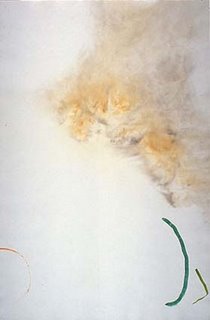
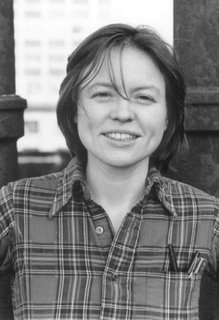




 I never saw DNA during their brief existence. I'm pretty sure my first exposure to them was on the Eno-produced album, "No New York" that my brother Drew owned that came out in '78. I liked what I heard then, however (this in a period where I was listening to almost nothing but avant-jazz) and Lindsay's name stuck in my head enough that when I saw things he appeared on a couple years later like the first records from Kip Hanrahan and the Golden Palominos, I picked them up. So when I noticed his gawky, hyper-dorky mug on the front of an album called "Envy", leading a bunch of musicians grouped under the iffy name, Ambitious Lovers, I went for it. They only made three albums--I have the first two on vinyl, the last, "Lust", on disc--though I assume, by virtue of the titles that severn were planned. Two salient facts stood out from "Envy", the first release. One was incorporating the once-removed funk of current (early 80s) Talking Heads into a looser, more openly avant format. The second, more interesting to me at the time, was threading Brazilian motifs and instrumentation into the mix, a music I was fairly ignorant of then. A year after the first Lovers' record, Lindsay would organize and produce Caetano Veloso's spectacular US debut album on Nonesuch. It was a good, gutsy move on Lindsay's part, revitalizing the music he'd been brought up on in Brazil, hearing how it could mesh with that of downtown NYC.
I never saw DNA during their brief existence. I'm pretty sure my first exposure to them was on the Eno-produced album, "No New York" that my brother Drew owned that came out in '78. I liked what I heard then, however (this in a period where I was listening to almost nothing but avant-jazz) and Lindsay's name stuck in my head enough that when I saw things he appeared on a couple years later like the first records from Kip Hanrahan and the Golden Palominos, I picked them up. So when I noticed his gawky, hyper-dorky mug on the front of an album called "Envy", leading a bunch of musicians grouped under the iffy name, Ambitious Lovers, I went for it. They only made three albums--I have the first two on vinyl, the last, "Lust", on disc--though I assume, by virtue of the titles that severn were planned. Two salient facts stood out from "Envy", the first release. One was incorporating the once-removed funk of current (early 80s) Talking Heads into a looser, more openly avant format. The second, more interesting to me at the time, was threading Brazilian motifs and instrumentation into the mix, a music I was fairly ignorant of then. A year after the first Lovers' record, Lindsay would organize and produce Caetano Veloso's spectacular US debut album on Nonesuch. It was a good, gutsy move on Lindsay's part, revitalizing the music he'd been brought up on in Brazil, hearing how it could mesh with that of downtown NYC. We all have gaping holes in our music collections I'm sure but some are just ridiculous. My pre-20th century Western classical holdings are minimal (hell, my 20th century ain't that great either) but, like pre-1960 jazz, this was largely a conscious, economic decision from way back, based on the fact that I could hear a great deal of this music on the radio on a fairly regular basis so I'd be better off purchasing things I was less likely to otherwise encounter. One of the reasons I was confident of hearing great unowned-by-me music over the airwaves was the existence of WKCR, the radio station of Columbia University.
We all have gaping holes in our music collections I'm sure but some are just ridiculous. My pre-20th century Western classical holdings are minimal (hell, my 20th century ain't that great either) but, like pre-1960 jazz, this was largely a conscious, economic decision from way back, based on the fact that I could hear a great deal of this music on the radio on a fairly regular basis so I'd be better off purchasing things I was less likely to otherwise encounter. One of the reasons I was confident of hearing great unowned-by-me music over the airwaves was the existence of WKCR, the radio station of Columbia University.
